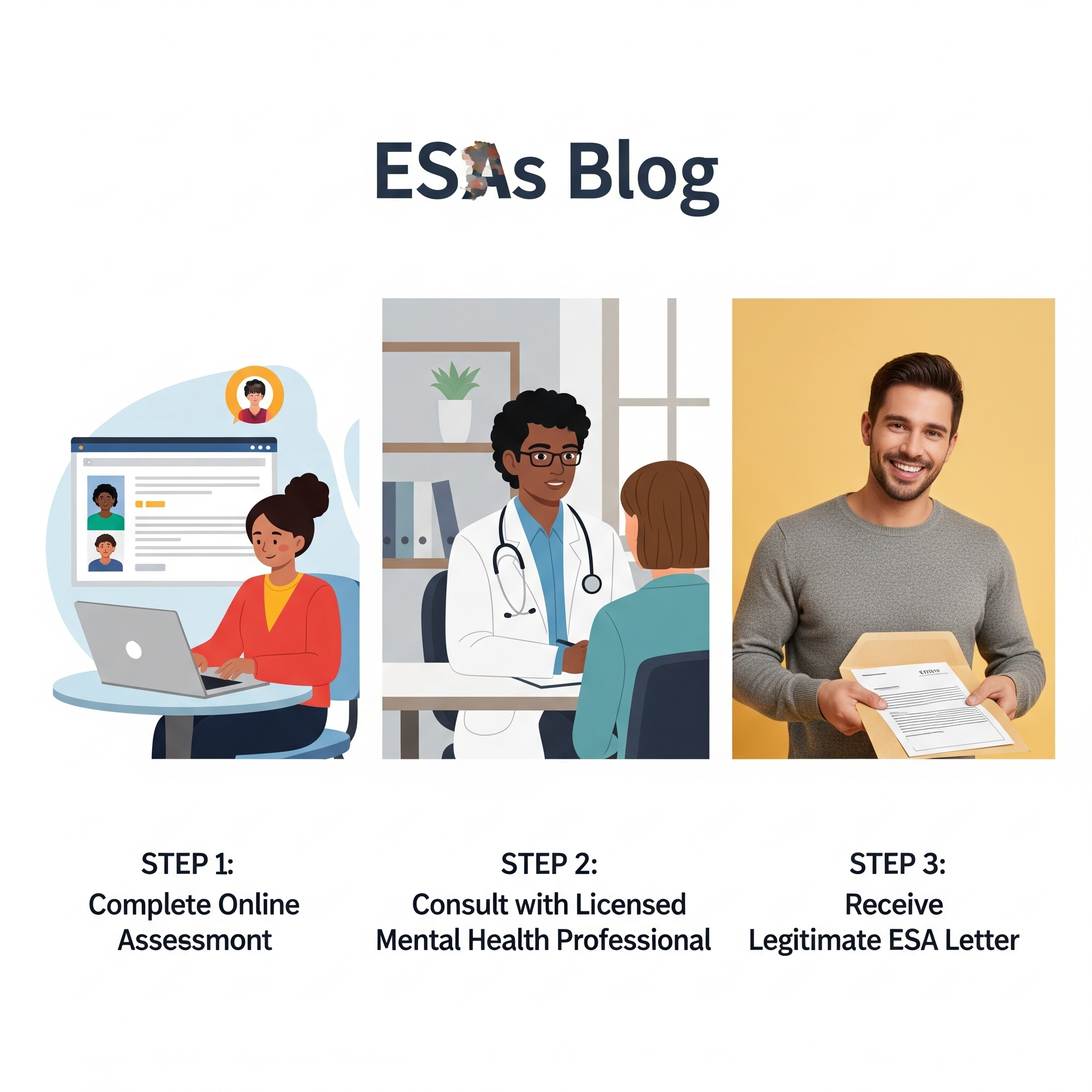Traveling can be challenging, but for individuals who rely on their Psychiatric Service Dogs (PSDs), air travel requires careful planning and preparation. Ensuring a smooth and stress-free journey for both you and your PSD involves understanding airline regulations, having the necessary documentation, and packing the right essentials. This comprehensive checklist, brought to you by CertifyESA, your trusted provider of legitimate ESA and PSD letters, will guide you through every step of flying with your invaluable companion.
Understanding Your Rights: The Air Carrier Access Act (ACAA)
Before diving into the checklist, it’s crucial to understand your rights as a passenger traveling with a service animal under the Air Carrier Access Act (ACAA). This federal law prohibits discrimination against individuals with disabilities in air transportation. According to the U.S. Department of Transportation (n.d.), airlines are required to accommodate service animals accompanying qualified individuals with disabilities, provided certain conditions are met. A psychiatric service dog, trained to perform specific tasks for an individual with a mental health disability, falls under this protection.
Pre-Flight Preparations: Weeks Before Your Trip
Thorough preparation is key to a seamless travel experience. Start these steps several weeks before your departure date:
[ ] 1. Verify Airline Policies:
- Action: Contact your chosen airline directly or visit their official website to understand their specific policies regarding service animals. Policies can vary between airlines, so it’s essential to get the most up-to-date information.
- Details to Inquire About:
- Required documentation (e.g., DOT Service Animal Air Transportation Form).
- Advance notice requirements for traveling with a service animal.
- Size and breed restrictions (though generally, these should not apply to legitimate service animals).
- Check-in procedures for passengers with service animals.
- In-cabin space allowances for your PSD.
[ ] 2. Gather Necessary Documentation:
- Action: Ensure you have all the required documentation to present to the airline.
- Essential Documents:
- DOT Service Animal Air Transportation Form: Most airlines now require this form to be completed and submitted in advance or at the airport. This form attests to your dog’s health, behavior, and training. You can typically find this form on the airline’s website.
- Veterinary Health Certificate: Obtain a current health certificate for your PSD from a licensed veterinarian, issued within 10 days of your initial flight. This certificate confirms that your dog is healthy and up-to-date on all necessary vaccinations.
- Identification Tags: Ensure your PSD wears a collar with identification tags, including your name, phone number, and address. Consider adding a tag indicating that your dog is a trained service animal.
- CertifyESA PSD Letter (Recommended): While not always explicitly required by the ACAA, having a letter from a licensed mental health professional recommending your PSD can provide additional clarity and support your need for your service animal. CertifyESA provides legitimate and compliant PSD letters that can streamline the airport process.
[ ] 3. Confirm Your PSD’s Training:
- Action: Be prepared to verbally confirm that your PSD has been individually trained to perform specific tasks directly related to your mental health disability.
- Examples of Tasks: Reminding you to take medication, providing tactile stimulation during moments of distress, interrupting repetitive behaviors, or guiding you to a safe place during an anxiety attack.
[ ] 4. Book Your Flight Strategically:
- Action: When booking your flight, consider factors that will enhance comfort for both you and your PSD.
- Tips for Booking:
- Direct Flights: Opt for direct flights whenever possible to minimize stress and layover time.
- Seat Selection: If possible, request a bulkhead seat or one with extra legroom to provide more space for your PSD to lie comfortably at your feet. Call the airline directly to discuss seating arrangements.
- Flight Timing: Choose flight times that align with your PSD’s routine for feeding and potty breaks.
[ ] 5. Prepare Your PSD for Air Travel:
- Action: Acclimate your PSD to their travel carrier (if you plan to use one in the gate area or during layovers) and the airport environment.
- Training Tips:
- Carrier Acclimation: Gradually introduce your PSD to their carrier, making it a positive and comfortable space with treats and familiar toys.
- Exposure to Airport Sounds: Play recordings of airport sounds (announcements, rolling suitcases) at low volumes to help your PSD get used to the noise.
- Practice Staying Calm in Busy Environments: Take your PSD to moderately crowded places (pet-friendly stores, outdoor cafes) to practice staying focused and calm amidst distractions.
[ ] 6. Plan for Potty Breaks:
- Action: Research designated pet relief areas at your departure and arrival airports, as well as any connecting airports.
- Information to Gather:
- Location of indoor and outdoor pet relief areas.
- Hours of operation (if applicable).
- Any specific requirements or procedures for using these areas.
Packing Essentials: What to Bring for Your PSD
Having the right supplies will ensure your PSD’s comfort and well-being during the journey:
[ ] 7. PSD Travel Kit:
- Essentials to Include:
- Food and Water: Pack enough of your PSD’s regular food for the entire trip, plus a little extra in case of delays. Bring a collapsible water bowl and consider freezing some water in a spill-proof container.
- Medications: If your PSD takes any medications, ensure you have an ample supply in their original labeled containers. Carry a copy of the prescription.
- Waste Bags: Be a responsible pet owner and bring plenty of waste bags for disposing of your PSD’s waste properly.
- Comfort Items: Include familiar items like a favorite blanket, toy, or chew to help your PSD feel secure in the unfamiliar environment.
- Small First-Aid Kit: Include essentials like antiseptic wipes, gauze, and any specific items recommended by your veterinarian.
- Leash and Harness: Ensure your PSD has a secure leash and harness or vest. The harness or vest can help identify them as a service animal (though it’s not a legal requirement).
- Travel Carrier (Optional but Recommended): Even if your PSD won’t be in the carrier during the flight, it can be useful in the gate area or during layovers for containment and providing a safe space. Ensure it meets airline size restrictions if you plan to bring it on the plane.
- Absorbent Pads: In case of accidents, pack some absorbent pads to clean up messes quickly and discreetly.
At the Airport: Navigating Security and Boarding
Arriving early and being prepared will make the airport experience smoother:
[ ] 8. Arrive Early:
- Action: Allow extra time for check-in, security screening, and any potential delays when traveling with a service animal. Aim to arrive at least 2-3 hours before your scheduled departure.
[ ] 9. Check-In Procedures:
- Action: Proceed to the airline’s check-in counter (even if you have a mobile boarding pass) to present your documentation and complete any necessary paperwork related to your PSD. Be prepared to answer questions about your dog’s training and the tasks they perform.
[ ] 10. Security Screening:
- Action: You and your PSD will need to go through security. Your PSD will typically need to walk through the metal detector. Be prepared to remove their collar and leash temporarily if requested. If your PSD cannot walk through the metal detector, inform the TSA officer, and they will conduct a hand-held screening.
- Tips for Security:
- Keep your PSD on a short leash and under control at all times.
- Be patient and cooperative with TSA officers.
- Have your documentation readily accessible.
[ ] 11. Boarding the Aircraft:
- Action: Passengers with disabilities and service animals are often invited to board the aircraft early. Take advantage of this to get settled and allow your PSD to adjust to the cabin environment before it gets crowded.
During the Flight: Ensuring Comfort and Safety
Once on board, focus on keeping both you and your PSD comfortable:
[ ] 12. Find a Comfortable Position:
- Action: Ensure your PSD has enough space to lie comfortably at your feet without obstructing the aisle or other passengers.
[ ] 13. Keep Your PSD Hydrated:
- Action: Offer your PSD small amounts of water throughout the flight.
[ ] 14. Manage Potty Needs:
- Action: If it’s a long flight, be mindful of your PSD’s need for potty breaks upon arrival. Utilize the designated pet relief areas at the arrival airport immediately after deplaning.
[ ] 15. Maintain Calm and Control:
- Action: Keep your PSD on a leash or harness throughout the flight and ensure they remain calm and well-behaved. If your PSD shows signs of anxiety, use familiar calming techniques.
Post-Flight: Arrival and Beyond
Upon arrival, ensure a smooth transition:
[ ] 16. Utilize Pet Relief Areas:
- Action: Immediately take your PSD to the designated pet relief area at the arrival airport.
[ ] 17. Ensure Your PSD’s Well-being:
- Action: Check on your PSD to ensure they are not overly stressed or uncomfortable after the flight. Offer them water and a small amount of food.
[ ] 18. Continue Routine:
- Action: Try to get back into your regular routine as soon as possible to help your PSD adjust to the new environment.
Conclusion: Fly with Confidence
Traveling with a Psychiatric Service Dog requires careful planning and adherence to airline regulations. By following this comprehensive checklist and ensuring you have the necessary documentation, including a potential PSD letter from CertifyESA, you can navigate air travel with greater confidence and ensure a safe and comfortable journey for both you and your invaluable companion. Remember to always prioritize your PSD’s well-being and be prepared for any unforeseen circumstances. Safe travels!
Reference:
U.S. Department of Transportation. (n.d.). Service Animals. Retrieved from [Insert relevant DOT webpage URL about service animals here]





